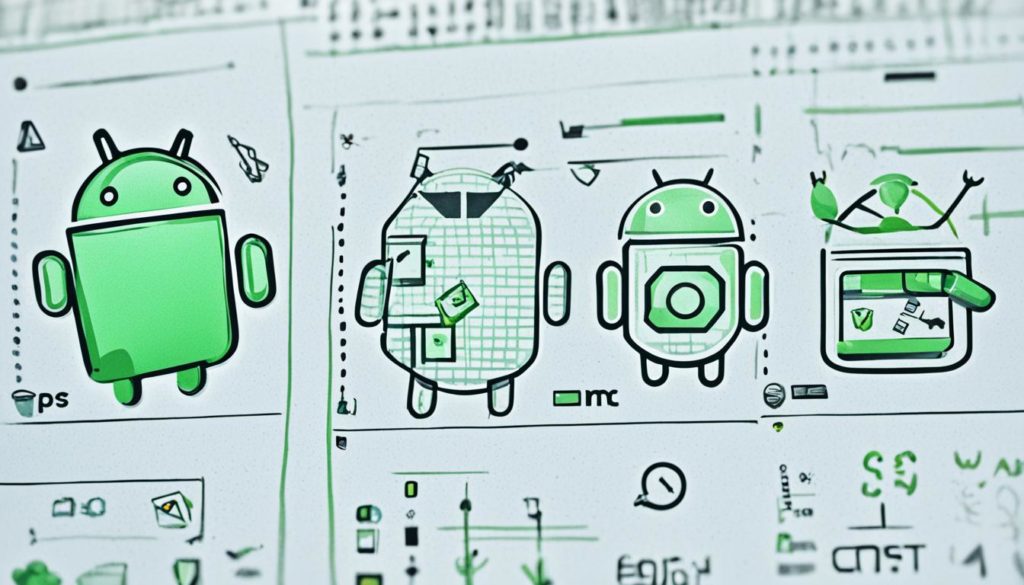
The digital world is always changing, and Mobile App Design plays a big role in growing businesses and engaging users. About 60% of jobs in the app world are for mobile app developers. This shows how creating apps that users love is key for business today. Using the best tools for design helps make apps that work well on all kinds of devices.
Good UI design is very important. Developers must think about how long people look at screens and their sizes to make apps everyone can use1. Getting your app on places like Apple’s App Store and Google Play means it meets high standards. Making a successful app combines creativity with smart engineering, using data from the real world.
Key Takeaways
- Mobile App Design is essential for unlocking business growth and user interaction.
- App developers play a significant role in the digital economy, with their expertise contributing to the majority of direct app economy jobs.
- User interface design must adapt to the diverse array of devices and screen sizes to meet user expectations.
- Accessing device features through advanced development tools supports a seamless user experience across different platforms.
- Launching apps via established marketplaces ensures they undergo a thorough approval process for quality assurance.
The Importance of UI/UX Design in Today’s Mobile Landscape
In our digital world, user interface design and user experience design have become crucial. Users spend about four hours daily on apps. A bad experience makes them 62% less likely to buy. That’s why businesses must focus on good UI/UX design to keep users interested. Good design captures and keeps users by making apps easy to use and user-friendly.
A fast and simple user interface can make or break a mobile app. If an app takes too long to load, people leave it. This highlights the need for apps to work smoothly and look good. A standout UI/UX design makes a brand memorable and different from others.
Statistics show that a well-designed app makes customers happier and more loyal. Today, users want apps to meet their specific needs. Sadly, half will delete an app once it does its job. This shows it’s important to create experiences that people value over time.
Excellence in mobile app development requires focusing on the user. This includes consistent design for a smooth experience and a brand identity users can connect with visually. Testing and updating based on data and user feedback are key. Below, see how different UI/UX strategies improve engagement and satisfaction:
| Design Feature | Impact on User Engagement | Benefits of Optimization |
|---|---|---|
| Intuitive Navigation | Guides user actions, boosts conversions | Aids in achieving business goals |
| Consistent Elements | Enhances familiarity, prevents abandonment | Contributes to loyal user base |
| Personalized Experiences | Creates sense of ownership, fosters connection | Leads to repeat usage, increased satisfaction |
| Animations & Microinteractions | Improves overall experience, encourages engagement | Boosts brand appeal and memorability |
| Accessibility | Shows inclusivity, reaches a wider audience | Enlarges user base, reflects caring brand image |
To truly benefit from UI/UX design, developers should use AR and VR for unique experiences4. Following responsive design practices is also vital2. The main goal is to create personal and rewarding user journeys that engage everyone.
Understanding Your User: The Foundation of Mobile App Design
The key to great mobile app design is knowing the users well. When developers and designers understand their users through market research, they make better apps. This focus ensures the apps meet and predict user needs for a superior experience.
Conducting Market and User Research
Learning about user preferences is crucial in app development. With over 5 billion mobile users worldwide in 2017, the audience is huge. To make the most of mobile shopping, which saw huge sales in 2018, apps must be easy to use and accessible to everyone, including those with disabilities.
Developing User Personas for Targeted Design
Designing for specific user personas leads to better apps. These profiles are based on how real people use their devices, taking into account various factors. This process helps designers focus on key features like easy offline access and user-friendly interfaces.
| Ergonomic Design Factor | User Interaction Improvement | Accessibility Consideration |
|---|---|---|
| Recommended font size (11 points minimum) | Reduces eye strain | Helps visually impaired users |
| Minimum touch target size (7-10 mm) | Enhances accuracy of touch interactions | Assists users with motor impairments |
| Interface design (center half to two-thirds) | Increases interaction with primary elements | Consideration for users’ natural thumb reach |
| Offline access | Provides uninterrupted usage in various environments | Essential for areas with poor connectivity |
Wrapping up, blending mobile app prototyping with tests and research is key. It leads to apps that not only meet, but exceed, expectations. These strategies help connect users and apps, making every interaction count towards more satisfaction.
Establishing Clear Objectives for Your Mobile Application
Setting clear mobile app objectives is key to aligning your app with business goals. It ensures the app meets customer needs. You start by knowing your niche and the issues your app solves. This marks your app development strategy‘s path to success.
Gauging customer stay, awareness, and engagement are goals that shape the app. Knowing your audience and industry-specific goals like downloads and ratings is vital.
Business aims must adapt as technology changes. Setting goals around user growth, engagement, and recognition guides app purpose and success. A definite app purpose aids not just in development, but also in getting users and optimizing app visibility post-launch.
App goals guide your growth and should be detailed, doable, and timely. They inform your choices and show your tech-based business direction. Aligning your app strategy with clear, targeted aims makes your app a valuable part of your business in a competitive environment6.
Visual Elements in Mobile App Design: Engaging Users at First Glance
The mix of visual design and visual hierarchy is key in making a great first impression. This is because good design uses the idea of size to show what’s most important in the app’s look. A careful mix of these parts creates a space that’s both pretty and works well, drawing users in from the start. For a mobile app, grabbing attention is about more than looking good. It’s about making a path that the eye wants to follow, telling a story on the screen.
Utilizing Visual Hierarchy and White Space
Using visual hierarchy well is crucial for directing user’s attention. It uses changes in size, shade, color, and space to lead the eye by importance. Also, smart use of white space helps keep users focused and makes reading easier. This is really important on small screens to avoid making them too busy.
Responsive Design for All Screen Sizes
Responsive design is key in today’s app making, making sure visuals work well on any device. Following responsive design makes sure visual elements keep their purpose, no matter the screen size. This follows the ideas of adaptability in visual hierarchy and design. Caring about these details makes the app look professional and builds trust with users.
Designing for Interaction: Tap, Swipe, and Beyond
Interactive elements like tapping and swiping are central to interaction design. They should feel natural for the user to use. By making different elements stand out through color or where they’re placed, designers can make interactive areas that lead users smoothly on their journey7.
Users want interactions that are both engaging and easy to get around. Designers need to blend these ideas into the app’s design. This prepares an app that’s responsive and focused on users, making it shine among competitors.
Creating a User-Centered Mobile App Prototyping Strategy
In the dynamic world of mobile app development, mobile app prototyping is key. It ensures apps meet the real needs of users. Taking cues from user-centered design, a 2015 study highlights how crucial early user feedback is. A 2019 research also shows the challenges in keeping mobile health app users engaged.
The field keeps growing, and UI/UX design methods are getting better. Insights from a 2017 report show how vital user-friendly design is, especially for digital health’s growth. A 2020 study during COVID-19 further shows the need for adaptable and empathetic app designs.
Using prototyping tools, designers can adjust based on 2019 findings on mental health app engagement. This approach helps build apps that truly reflect what users want. A 2022 review showcases the rise of design that puts user needs first, especially in digital mental health.
Taking ideas to fully working apps requires evidence-based methods. Blending user-centered design with agile prototyping creates impactful and functional digital health solutions. They meet users’ needs and improve well-being.
Mobile App Testing: Optimizing for Performance and Usability
The demand for top mobile experiences makes mobile app testing and performance optimization crucial. Testing confirms an app’s correctness, functionality, and usability before it goes public.
Functional, performance, accessibility, and compatibility tests are key. They ensure an app’s strength and readiness for the market.
Functional Testing to Ensure Reliability
Functional testing checks if an app works as expected. Through unit tests, end-to-end tests, and more, developers check different app parts. This makes the app stable and performs well.
A balanced testing strategy focuses on test quality, speed, and dependability. It shows the need for thorough quality checks.
User Feedback Loops and Iterative Design
“Engaging users in the development process through user feedback loops is crucial for successful iterative design.”
Adobe Consulting, Microsoft, and DAZN use platforms like UserTesting for insights. This helps improve app performance and usability. Integrations and AI tools enhance user experiences. Over 3,000 top brands count on these for standards.
| Test Type | Focus Area | Benefits |
|---|---|---|
| Unit Tests | Small Components | Speedy, targeted testing |
| End-to-End Tests | Integrated Functionality | Comprehensive validation |
| Performance Testing | App Responsiveness | Ensures smooth operation |
| Accessibility Testing | User Inclusivity | Widens user base |
| Compatibility Testing | Device Consistency | Guarantees uniform experience |
Breaking down the app lets developers focus on issues better. Platforms offer feedback for smart design changes. User feedback greatly improves user interfaces. This sets a high standard in mobile app testing.
Conclusion
In the world of business today, app development is key. It’s like a vital thread woven into how businesses grow and how users enjoy their online experiences. Almost 70 percent of smartphones use Android. This shows how important Android’s wide reach is. But, iOS apps keep users coming back more often. So, paying USD 99 a year to be in the Apple ecosystem makes sense. Knowing these facts helps in creating mobile app growth strategies that really work. The goal is to not just meet, but go beyond what users hope for.
The digital world is changing fast. Now, mobile devices and apps are how most people get on the internet. It’s not just regular people. Even doctors and nurses use smartphones or tablets at work. A huge 87% of them do. Google Play Store’s open policy means more apps and more ways for people to connect. Unlike Apple’s App Store, it’s less restricted. This makes improving UI/UX even more important today. Many companies launch apps to make talking to users easy and quick.
To truly benefit from mobile tech, you have to build an experience that users love. It’s about creating something that not only works well, but also wins over users. By focusing on user-first design and constant improvements, apps can thrive. In doing so, mobile app design and strategy work together. They help a business stand out in the crowded online world.
FAQ
How does mobile app design contribute to business growth?
Mobile app design boosts business by making the brand more recognizable. It enhances how users interact with the app. A well-crafted app keeps users coming back, increasing sales.
Why are UI and UX design essential in mobile app development?
UI and UX are crucial for an app’s look and feel. They make the app both functional and appealing. This draws in and keeps users, setting the app apart from competitors.
What is the significance of conducting market and user research in app design?
Market and user research are key to understanding what users want. It shows what competitors are doing. This knowledge ensures apps meet users’ needs, leading to their success.
How do developing user personas aid in mobile app design?
Creating user personas helps focus the app’s design. It represents the various users of the app. This approach makes the app more user-friendly and personal.
What are mobile app objectives, and why are they important?
Mobile app objectives outline the app’s goals. They ensure the app matches the business’s mission. Objectives keep the development on track, ensuring each feature is useful and solves user problems.
How do visual elements like hierarchy and white space influence user engagement?
Visual hierarchy and white space make content clear and attractive. They highlight key information first. Using space well makes the app easy to read, improving user experience.
What is the role of responsive design in mobile app development?
Responsive design makes apps work well on any device. It adjusts the layout for different screen sizes. This flexibility increases user satisfaction by making apps easy to use everywhere.
Why is designing for interaction important in mobile apps?
Designing for interaction focuses on how users operate their devices. It makes sure the app is easy to navigate. This enhances the user’s experience and satisfaction.
What is the purpose of mobile app prototyping?
Prototyping is a test phase for app design. It lets designers and developers refine the app’s features. Catching issues early ensures the app meets user expectations.
How do functional testing and user feedback loops enhance mobile app optimization?
Functional testing checks if the app works right. User feedback loops gather users’ opinions for improvements. Together, they perfect the app’s performance and user experience.
Future App Studios is an award-winning software development & outsourcing company. Our team of experts is ready to craft the solution your company needs.










